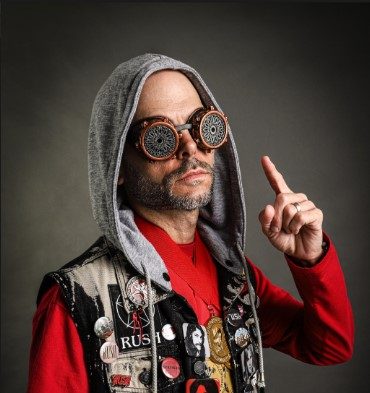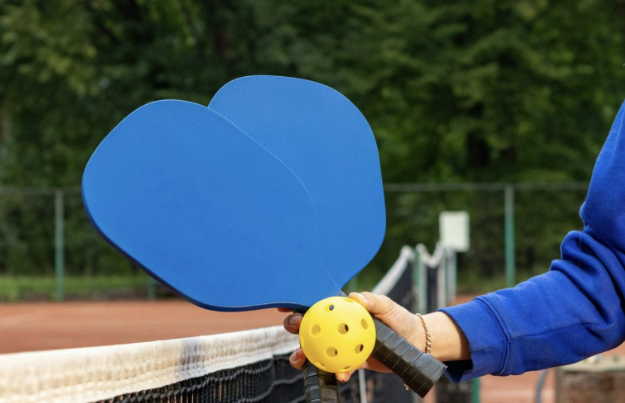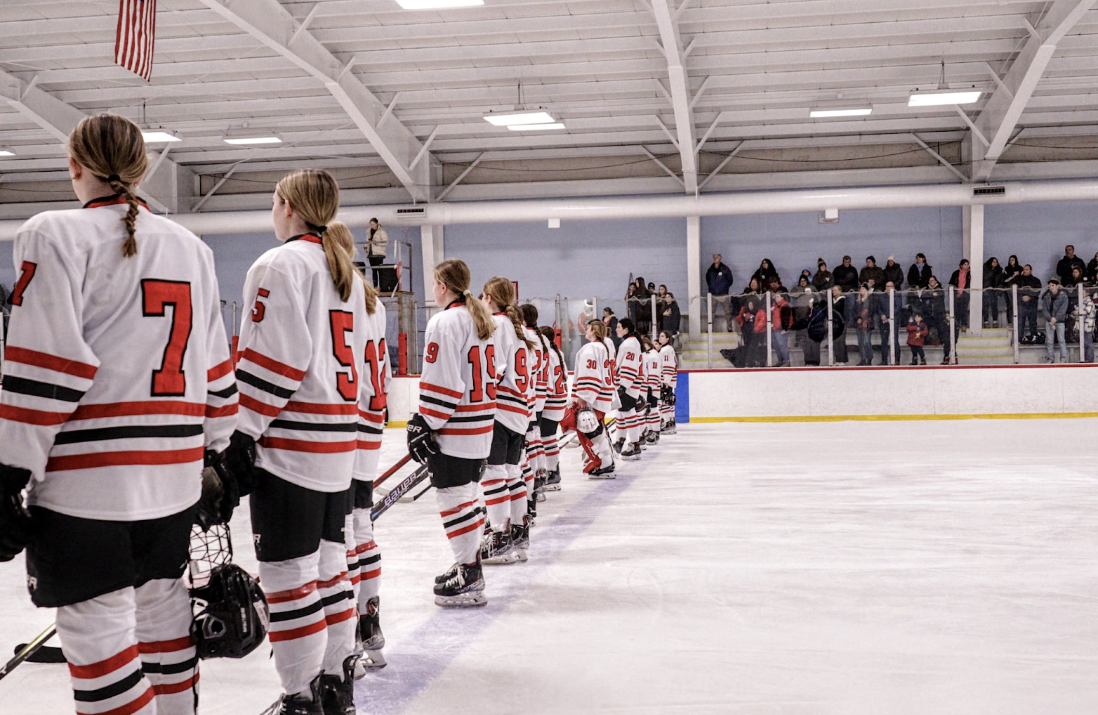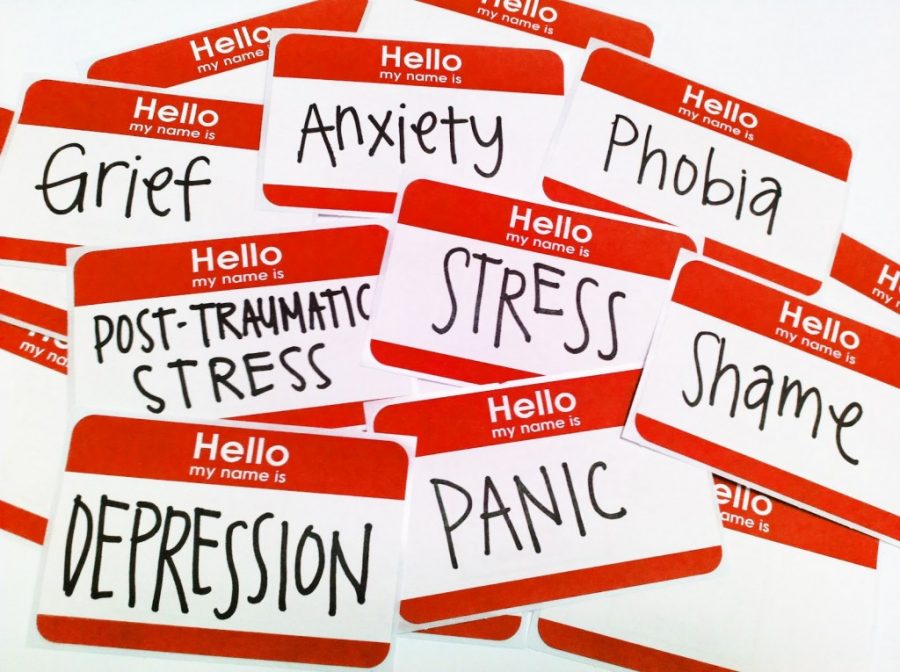Mental Disorders Are Not Adjectives
A pile of name tags with mental disorders written in place of names, emphasizing the ways in which society unfairly defines mentally ill people by their illnesses.
April 1, 2018
In the halls of Hingham High School, or in any high school for that matter, you can almost always hear references to a mental disorder or two.
“I hate when my locker’s dirty, I’m so OCD,” exasperates one student.
“If I fail this test, I’m actually going to kill myself,” declares another.
“This class actually makes me depressed,” says a third.
“I can’t even focus right now. It’s like I have ADHD!”
“You completely misread that. Are you dyslexic or something?”
“You’re a psycho!”
The list goes on.
It seems that many Hingham High students have taken to equating actual mental disorders to adjectives that describe slight inconveniences or to using mental disorders as insults directed toward themselves or others. Although these students mean no harm, it is important to recognize that it is harmful. Especially for students who legitimately struggle with mental disorders.
When students casually joke about or demean mental disorders, it makes it all the more difficult for affected students to speak up or seek help. Oftentimes, when these students do express their grievances, they’re shrugged off as just another dramatic kid. Other times, the negative stigma surrounding mental illness makes it so that mentally ill students do not even recognize their symptoms, or so that they fear the very prospect of speaking up about what they are going through.
To many students at Hingham High, however, this issue may seem far away, or irrelevant to their lives. How common are mental disorders, anyways?
Far more common than you might think.
In fact, the National Comorbidity Survey: Adolescent Supplement, or the NCS-A, which is widely considered to be one of the most credible national surveys, found that almost half (49.5%) of children in the United States aged 13-18 suffer from at least one mental disorder, if not more. That translates to about 1 in every 2 teenagers dealing with some type of mental disorder, and that does not even take into account the amount of undiagnosed teens and teens who have either yet to understand the symptoms or admit that they have them.
The NCS-A is particularly important because it acknowledges a wider range of mental disorders than other studies do, thus recognizing struggling teens who usually do not receive the attention they deserve. The survey classifies any forms of ADHD, conduct disorders, and oppositional defiant disorders as mental disorders, broadening the range for teens who can be empowered to seek the help they need.
According to the World Mercury Project, the Centers for Disease Control and Prevention (CDC) commended the NCS-A for its unique focus on and inclusion of childhood mental disorders that are not normally catered to.
Furthermore, according to Here to Help, a majority of mental illnesses (50-70%) first appear in adolescence, before the age of 18. This means that mental disorders have extremely prevalent impacts on childhood development. This means that mentally ill people tend to struggle the most in their teenage years. This means that high schoolers, at Hingham High and across the world, need access to mental health education and treatment; what they certainly don’t need is for their peers to chalk their disorders up to jokes or novelties.
These numbers are staggering. They are upsetting. But what’s worse is that most of these children, almost a whopping 80% of them, will not receive the mental health services that they clearly need.
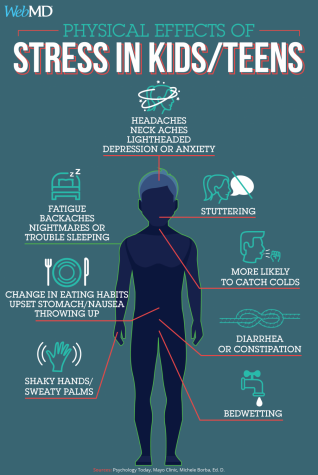
A depiction of the physical impacts that mental disorders can have on children and teenagers.
More often than not, this neglect has visibly negative consequences: truancy, failing grades, inappropriate behavior, and even dropping out. Sometimes the repercussions aren’t as visible. Sometimes they manifest themselves as self-loathing, sleepless nights, intrusive thoughts, and isolation. While the effects may differ, the cause is the same: the negative stigma surrounding mental disorders does far more harm than it could ever do good.
It is important to know what mental disorders are most prominent in teenagers and how to recognize the signs. It’s also important to understand these disorders and treat them seriously, so as to be a helpful ally as opposed to a hindrance for mentally ill teens.
Of all mental disorders, depression is the most common in teens. According to the Center for Discovery, a total of 20% of teens struggle with depression and 10-15% of teens suffer from symptoms at any given time, yet only 30% of these depressed teens receive the necessary treatment for their conditions. This has led to some more striking statistics: every 100 minutes a teen commits suicide, and suicide is the 3rd-leading cause of death in teens. Depression can lead to adolescents isolating themselves, withdrawing from social activities, falling behind in their classes, and overall putting less effort into things they once actively participated in. Depression is not what one feels when he or she must attend a boring class; depression provides a huge impairment to daily life.
Anxiety disorders are also commonly seen mental disorders in youth; sometimes, people with depression also have other disorders such as anxiety disorder. Around 6% of adolescents experience anxiety disorder. Anxiety disorders are characterized by overwhelming feelings of worry, anxiety, and fear that are significant enough to interfere in daily activities. Anxiety is not just a sense of nervousness; it is a disorder that can inhibit living on a day-to-day basis.
Attention-deficit/hyperactivity disorder, or ADHD, is another mental disorder that affects the daily lives of adolescents. ADHD impacts nearly 5% of American youth. ADHD is defined by attention difficulty, hyperactivity, and impulsiveness, all of which impair a child’s ability to focus and remain idle, especially in classroom environments. ADHD is not simply the feeling a student gets when he or she is struggling to pay attention to what the teacher says; it is a chronic condition that some teens deal with constantly.
Conduct disorder is next, affecting about 3% of children. Conduct disorder includes a range of antisocial behavior. This disorder can cause children to exhibit extremely aggressive and destructive behavior towards other people, animals, or properties. Minors struggling with conduct disorder are also far more likely to regularly ditch school or even run away from home. Do not be so quick to label students who do poorly in school as “dumb” or “uncaring.” Sometimes these students care the most, but they have more going on behind the scenes.
Psychosis is another condition that affects adolescents, and it is also a condition that is often demonized or villainized in the entertainment industry and media. Psychosis is characterized by the loss of contact with reality. The disorder affects about 3% of the total population, but the symptoms tend to first show themselves in later adolescence. Oftentimes, those who live with psychosis also struggle with one of the other disorders mentioned in this article. Unlike the media suggests, people affected by psychosis are not more likely to be serial killers, and they are not “crazy.” The excessive use of the word “psycho” with negative connotations is damaging for those dealing with psychosis.
Between 1% and 3% of children and teens have Obsessive-Compulsive Disorder, or OCD, which makes it one of the most common disorders in teens. According to Evolve Treatment, about 40% of children who develop OCD will recover from the disorder by adulthood. However, the remaining 60% usually develop severe and chronic OCD. Those who struggle with OCD have an increased risk of suicide, which is highered still when they also have something like an anxiety disorder. OCD entails obsessive thoughts and compulsive behaviours, both of which are unwanted and intrusive. Common obsessions include worry about sexuality; fear of germs and illness; worry about something bad happening, such as a loved one becoming ill or dying; disturbing thoughts, urges, and images; fear of committing a violent act; and more. Common compulsions include frequently cleaning; excessively putting things in order; needing everything to look and feel symmetrical; counting; constantly checking things, like whether or not the door is locked even though it has already been checked numerous times previously; repeating actions until something is “perfect”; seeking reassurance constantly; and more. OCD is certainly not just being a “neat freak” or the desire to remain organized–OCD is a constant, intrusive presence that infringes on daily life.
Another commonly seen mental illness in teens is bipolar disorder, a mood disorder that affects up to about 1% of American youth. Bipolar disorder usually first appears during the teenage years, and it is characterized by extreme changes in mood. A bipolar person experiences a back-and-forth between between extremely high moods, called mania, and extremely low moods, called depression. Bipolar disorder is not just a mood swing; it is the severe and unpredictable change in mood that can alter one’s ability to function for days at a time.
Issues with self image and identity are very recurrent with teenagers, and these issues sometimes result in damaging disorders. Eating disorders are often the results of self-hatred rooted in the obsessive desire to lose weight. Anorexia is a self-starvation disorder that affects up to 1% of young males and females aged 15-24. Bulimia, an eating disorder defined as bouts of excessive eating followed by self-induced vomiting or purging, affects up to 3% of young people. Eating disorders pose extreme risks to the health and wellbeing of those who have them. Jokingly calling a skinnier person “anorexic” ignorantly ignores the serious problems that lead to and come from eating disorders.
Another mental disorder seen in teens that is often demonized by popular media is schizophrenia. Schizophrenia impacts about 1% of the total population, but it usually shows up between the ages of 15 and 25. Schizophrenia worsens one’s ability to think, speak, feel, and behave clearly and in an organized way. Schizophrenics can also lose touch with reality. But schizophrenia is not the makings of a killer or any type of dangerous individual, like horror movies might make you think. Schizophrenics are valid people dealing with disorders.
There are many ways to help students dealing with any of these disorders, and they all start with abolishing the stigma surrounding them. Recognize that the illnesses are there, and do your part in respecting those who struggle with them. Stop using the terms loosely, as insults, or as methods of self-deprecation. Realize that, behind every mental disorder, there are real people with real problems. Educate yourself on the illnesses–understand the symptoms and how to help when a classmate might experience an attack of some sort. As students, the best way to be of assistance is to be an ally.
But creating an environment of acceptance is half of the battle. Mental illnesses seem to be on the rise–whether this is because they are now more common or because people are finally starting to recognize the symptoms for what they are is unknown. Either way, schools must do their part in assisting the needs of mentally ill students. Mental health should be a topic discussed more frequently and openly in classroom environments. Oftentimes, mental disorders are portrayed as weakness or sources of embarrassment, so those who suffer from them tend not to seek the treatment they need. This is endlessly damaging and completely inaccurate. Mental illnesses are just as valid as physical illness and should be handled as such.
“I think it’s really messed up that people still think mental illness is self-inflicted. It should get the same response as breaking an arm; [mentally ill students] can’t help it,” expressed junior Clara Kingsbury.
To ensure this, mental health training for staff should be a necessity. Mentally ill students are often forced into compromising positions because teachers, usually at no fault of their own, do not know any better. When a student suffering from severe anxiety disorder cannot present in front of the class or an extremely depressed student has fallen behind on homework, these disorders should be seen as just as inhibiting as any physical illness is and the student’s health should be taken into account in regards to grading and such. If a student breaks a leg, he or she is not forced to participate in gym class; the same should go for mentally ill students.
Junior Nicole Croteau feels that “mental disorders need to be treated by teachers, peers, and friends the same as any kind of sickness, and I think having a mental illness should justify an excused absence and teachers should be more understanding about it.” Mentally ill students need to be given the treatment and respect that they deserve because, otherwise, the suffering only continues.
In conclusion, depression is not the feeling you get after a test and ADHD is not when you can’t bother to concentrate in class. OCD is not characterized by a clean room and bipolar disorder is not simply a change in mood. These disorders are issues that people deal with at varying levels. Every mental ill person has his or her own personal experience. Tossing mental illnesses around as insults towards other people or as statements of self-deprecation is nothing short of cruel, especially when it is likely that someone who overheard you could be mentally ill. Recognize the symptoms and know the complexities behind the illnesses. Be considerate of the trials of others. Because mental illnesses are not jokes, they are not insults, they are not just teenagers being over dramatic, and they are not adjectives.
Mental Health Awareness Month will be May of this year. Educate yourself now so you can show your support then!
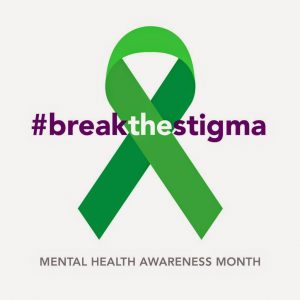
The ribbon designated for Mental Health Awareness.






















